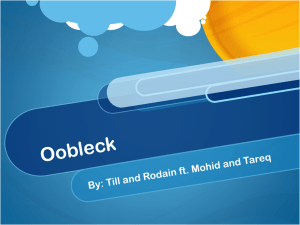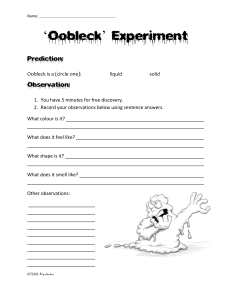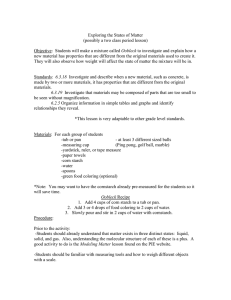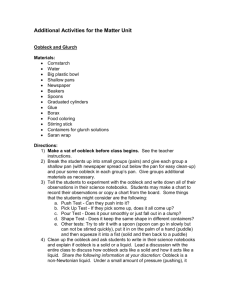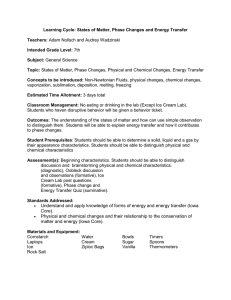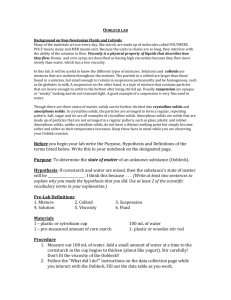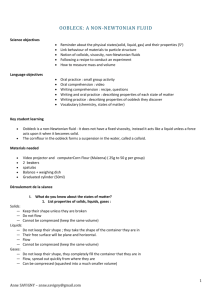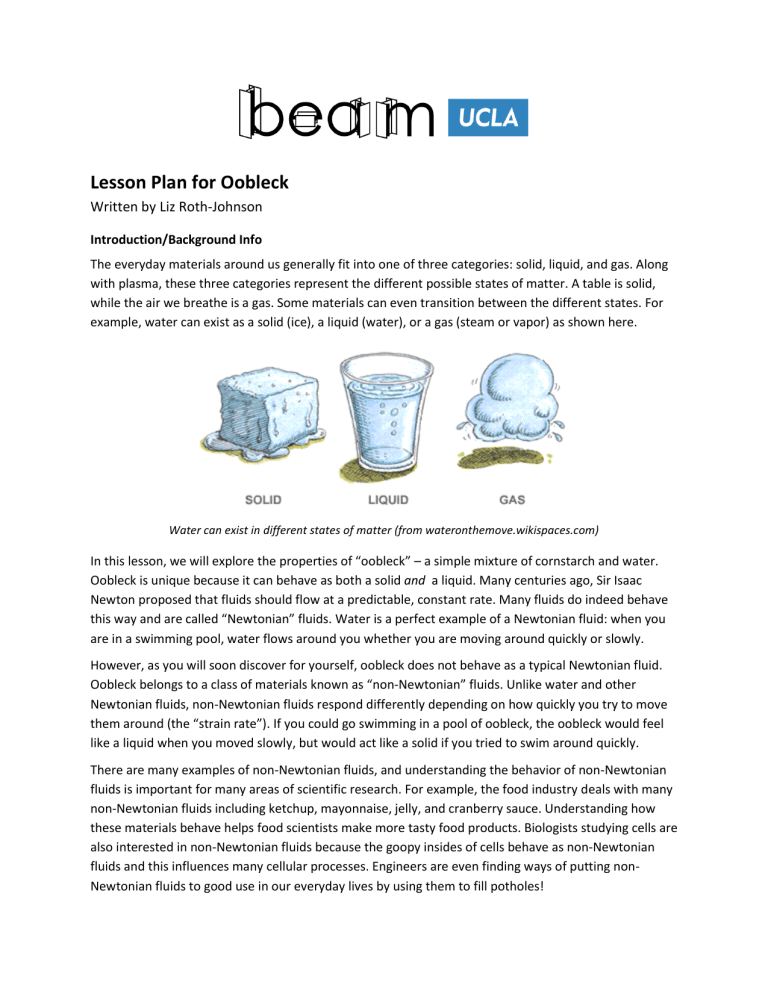
Lesson Plan for Oobleck Written by Liz Roth-Johnson Introduction/Background Info The everyday materials around us generally fit into one of three categories: solid, liquid, and gas. Along with plasma, these three categories represent the different possible states of matter. A table is solid, while the air we breathe is a gas. Some materials can even transition between the different states. For example, water can exist as a solid (ice), a liquid (water), or a gas (steam or vapor) as shown here. Water can exist in different states of matter (from wateronthemove.wikispaces.com) In this lesson, we will explore the properties of “oobleck” – a simple mixture of cornstarch and water. Oobleck is unique because it can behave as both a solid and a liquid. Many centuries ago, Sir Isaac Newton proposed that fluids should flow at a predictable, constant rate. Many fluids do indeed behave this way and are called “Newtonian” fluids. Water is a perfect example of a Newtonian fluid: when you are in a swimming pool, water flows around you whether you are moving around quickly or slowly. However, as you will soon discover for yourself, oobleck does not behave as a typical Newtonian fluid. Oobleck belongs to a class of materials known as “non-Newtonian” fluids. Unlike water and other Newtonian fluids, non-Newtonian fluids respond differently depending on how quickly you try to move them around (the “strain rate”). If you could go swimming in a pool of oobleck, the oobleck would feel like a liquid when you moved slowly, but would act like a solid if you tried to swim around quickly. There are many examples of non-Newtonian fluids, and understanding the behavior of non-Newtonian fluids is important for many areas of scientific research. For example, the food industry deals with many non-Newtonian fluids including ketchup, mayonnaise, jelly, and cranberry sauce. Understanding how these materials behave helps food scientists make more tasty food products. Biologists studying cells are also interested in non-Newtonian fluids because the goopy insides of cells behave as non-Newtonian fluids and this influences many cellular processes. Engineers are even finding ways of putting nonNewtonian fluids to good use in our everyday lives by using them to fill potholes! Student Objectives Understand qualitatively what distinguishes solids and liquids Observe the non-Newtonian characteristics of oobleck first-hand Be able to make simple predictions about the behavior of non-Newtonian fluids Overview of Lesson Process Introduce the states of matter and brainstorm properties of liquids and solids (10 min) Break into smaller groups and make oobleck. Determine whether it behaves more like a solid, a liquid, or a combination of the two (15 min) Continue playing with the oobleck to establish how its behavior relates to strain rate (15 min) Review and discuss the findings of your oobleck experiments. Brainstorm other non-Newtonian fluids in everyday life and discuss potential uses for non-Newtonian fluids (10-15 min) Clean up any oobleck messes you might have made (5-10 min) If there is extra time at the end, show students fun oobleck videos (5-10 min) Materials Water Cornstarch Bowls Spoons Ziploc bags Food coloring ½ cup per group 1 cup per group 1 per group 1 per group 1 per group A couple drops per group Smart&Final OfficeMax (20142757) 125 bowls Smart&Final OfficeMax (23076234) 500 bags Smart&Final $0.00 $10.00 $31.99 $10.00 $30.49 $5.00 Total $87.48 Procedures Part 1: Liquids & Solids 1. As a group, brainstorm the different properties of liquids and solids. Write down your ideas. Some examples: liquids flow, splash, take the shape of the container they are in; solids hold their shape, resist forces like pushing or hitting. 2. In small groups, make a bowl of oobleck: a. Put 1 cup of cornstarch in a bowl and add 1-2 drops of food coloring (optional). b. Slowly add up to ¾ cup water while mixing, until all the cornstarch is wet. c. Keep adding water until the oobleck feels like a liquid when mixed slowly. d. Oobleck is done when it is no longer powdery (needs more water) but doesn’t splash when hit with a spoon (needs more corn starch). 3. Use the list you made in step one to systematically test whether oobleck behaves like a solid or a liquid. It may be helpful to also test a bowl of pure water for comparison with a “true” liquid. Does the oobleck flow? What happens when you squeeze it in your hand? Hit it with a spoon? What happens to the water when you do the same? Part 2: Understanding Oobleck and Non-Newtonian Fluids 4. After establishing that oobleck can act like a solid and a liquid, explore how these behaviors relate to the “strain rate” – how fast you try to move or perturb the oobleck. a. Try stirring the oobleck with your finger. If you stir quickly, the oobleck should resist. If you stir slowly, the oobleck should give way. b. Try modeling quicksand (another non-Newtonian fluid) by letting your fingers sink to the bottom of the bowl and trying to remove them quickly. What happens? c. Try your hand at levitation! Put the oobleck into a lightweight bowl or cup. Dip your fingers or a spoon into the oobleck and then quickly lift upward. You should be able to momentarily bring the entire container up in the air before it starts falling down. Part 3: Wrap-Up Discussion 5. Review your findings from playing with the oobleck. Was it solid, liquid, or both? How did it’s liquid-like and solid-like properties correspond to how quickly or slowly you moved the oobleck? Sir Isaac Newton proposed that fluids should flow at a predictable, constant rate. While this is true for many fluids, like water, some fluids like our oobleck behave differently when different rates of forces are applied to them. These types of fluids are called “non-Newtonian” fluids. 6. Brainstorm some everyday examples of “non-Newtonian” fluids. Some examples: ketchup, jelly, mayonnaise, cranberry sauce, blood, quicksand, and silly putty. a. Note that there are different types of non-Newtonian fluids. Some (like oobleck and quicksand) become more solid as you try to move them, while others (like ketchup and mayonnaise) actually become more liquid as you try to move them! 7. Try to think of some useful applications for a non-Newtonian fluids like oobleck. Some college students recently came up with the idea to fill potholes with bags of non-Newtonian fluid. The oobleck flows slowly to fill the pothole but responds like a solid when a car drives over it. 8. If there is more time at the end, show the students some fun videos. a. Non-Newtonian pothole fillers (1 min): http://youtu.be/XrvzZewPUJA b. Oobleck on speakers (1.5 min): http://youtu.be/3zoTKXXNQIU c. Walking on oobleck (20 sec): http://youtu.be/bIOGL4eZnjs d. Sinking in oobleck (40 sec): http://youtu.be/Lb9kt1z3jAA e. Time Warp high-speed (6 min): http://youtu.be/S5SGiwS5L6I Resources Here are a few good websites with instructions and ideas for playing with oobleck: Kidzone: http://www.kidzone.ws/science/cornstarch.htm Exploratorium: http://www.exploratorium.edu/science_explorer/ooze.html Science Bob: http://www.sciencebob.com/blog/?p=608 Worksheet for Oobleck We usually think of the materials around us being a solid, a liquid, or a gas. In this activity, you will investigate a strange material called oobleck. With your class, create a list of the different properties of liquids and solids: Properties of Liquids Properties of Solids With your group, test all of the solid and liquid properties from the two lists you just made. Circle the properties that describe how oobleck behaves. Does oobleck behave like a liquid, a solid, or both? Can you think of any other materials that behave like oobleck? What is one way engineers have used a material like oobleck to help people?
